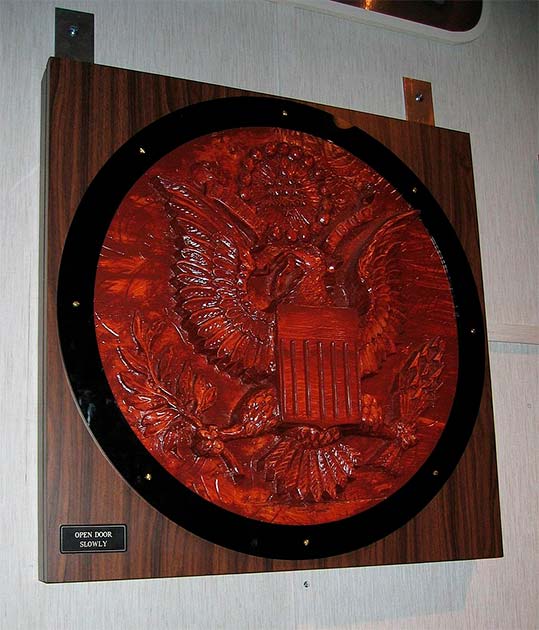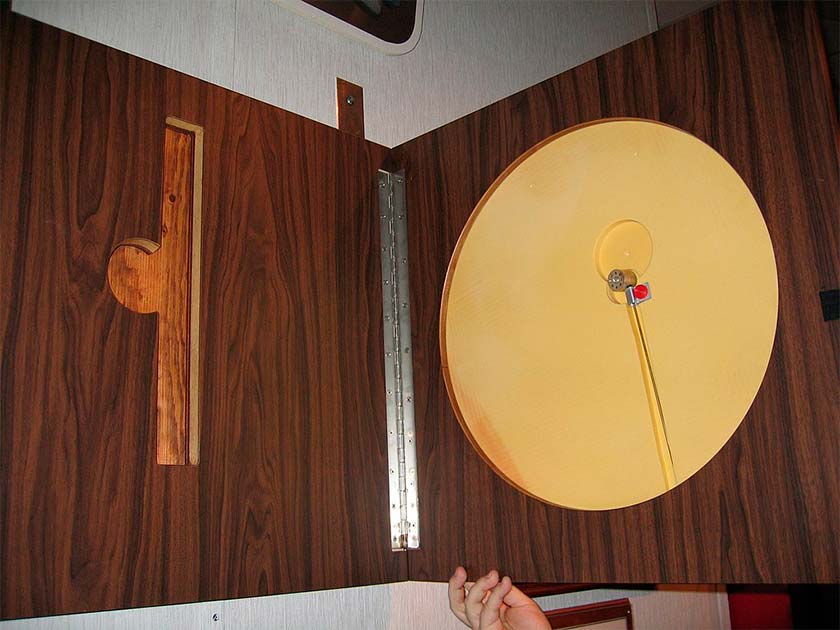One of the best parts of a James Bond film is when Agent 007 receives his fantastical espionage devices from the quartermaster Q. Cigarettes with cyanide, a parking meter loaded with tear gas, and even a jetpack were used by Bond in his many adventures.
While movies are very different from real life, there have been some creative devices that were created for spies during World War II. We all have heard of the absurd rodent bombs, escape maps hidden in playing cards, bombs disguised as a piece of coal, and hollow boot heels that hid knives or compasses.
But one of the most fascinating spy gadgets in history was a small and straightforward listening device that the Soviet Union developed, which they used to listen in on meetings between US officials for a period of seven years without being detected. The device was given the name “The Thing” because when it was discovered, nobody could figure out what it was or how it worked at first.
What was The Thing, and how did it work?
The Thing
The Thing, also called the Great Seal Bug (which rather gives the ending away), was a unique covert listening device that utilized passive listening techniques to transmit audio undetected. The Thing was presented as a gift from a group of schoolchildren from a mandatory youth organization in the Soviet Union known as The All-Union Pioneer Organization named after V. I. Lenin (Всесоюзная пионерская организация имени В. И. Ленин), aka the Young Pioneers.

The Young Pioneers gave The Thing, disguised in a wooden carving of the Great Seal of the United States, to the then United States Ambassador to the Soviet Union, W. Averell Harriman, on August 4, 1945. Obviously the US was delighted to receive this gift from Soviet schoolchildren, which they saw as a gesture of friendship.
The Thing was a simplistic yet brilliant covert listening device made by someone who might surprise you. The Thing was created by Lev Termen, better known as Leon Theremin. Theremin was a Soviet inventor who is best known for his electronic musical instrument, also called the theremin.
A theremin is an instrument that uses two metal antennas to create an electric frequency that can be manipulated by moving your hands in the frequency area. Theremins have an ethereal sound and have been used frequently in fantasy and sci-fi soundtracks.
The Thing itself was a small 9-inch (23 cm) long wire embedded into a hollowed-out cavity inside the carved wooden plaque of the Great Seal. Small holes were drilled into the beak area of the eagle on the seal, which allowed The Thing to “hear” conversations occurring in proximity to wherever it hung.
What made The Thing unique was that the device only weighed 1.1 ounces (31 grams) and had no external wires or even a power source. The Thing was able to “capture sound waves and modulate the radio waves that triggered the device, transmitting it [the sound] back to receivers.”
The device didn’t even need to be turned on; rather, it was “illuminated” by strong radio signals from outside the seal, which would activate it. The lack of a necessary power source made The Thing have an unlimited life span and go undetected for seven years because it was dead silent when the bug was inactive. The Thing was in fact an early form of radio-frequency identification (RFID) technology we now use commonly today.
The Spaso House and the Discovery
Since 1933, the sunny yellow Spaso House located at No. 10 Spasopeskovskaya Ploshad (Square) has been the residence of the United States Ambassador to the Soviet Union (and since 1991, Ambassador to the Russian Federation). The Spaso House is a beautiful neoclassical building near The Pushkin State Museum of Fine Arts and the Moscow River in the historic Arbat district of Moscow.
W. Averell Harriman hung the Great Seal in a place of prominence along a back wall in the Spaso House’s library. Meetings with high-level US politicians occurred in the library. Every secret discussion that occurred in the library was heard by The Thing and the Soviet Union for a staggering seven years!
The Thing was the perfect bug, and in fact so perfect that it was only discovered by accident in 1951 by a British radio technician operating inside the British Embassy. The operator was able to hear Americans having a discussion on an open radio channel from the Soviet Air Force.
- The CIA and the Death of President Jaime Roldós
- Julia Child and her Years Working for US Intelligence
The Soviets were accessing the information from The Thing by beaming radio waves directly at the Spaso House. After being alerted that the British heard their American allies’ private conversations, the State Department launched its own investigation at the Spaso House.
Joseph Bezjian and John W. Ford were sent from Washington DC to Moscow in March 1951 to investigate any bugs in the ambassador’s residence and the Canadian and British embassy buildings as well. It was clear the Soviets had gained access to private discussions, but how?

Ford and Bezjian used a signal generator and a receiver in order to conduct a counter-surveillance sweep of the ambassador’s office. During the sweep, the Great Seal carving produced audio feedback, which was unexpected.
The Thing was analyzed by the US Naval Research Laboratory, the Federal Bureau of Investigation, the Central Intelligence Agency, the British spy agency MI5, and the Marconi Company, which was a British telecommunications and engineering company. Due to the simplicity of The Thing, those who analyzed it couldn’t figure out how it worked. While The Thing was discovered and how it worked was figured out, nobody said a word about the device until May 1960.
Things finally came to a head at a meeting of the United Nations Security Council, which was called in May of 1960 in the Soviet Union in response to the U-2 incident. The U-2 incident was when on May 1, 1960, the Soviet Union shot down a US U-2 plane that passed into Soviet airspace.
The Soviets then accused the United States of spying on the Soviet Union and called a UN council meeting to discuss this outrage. On the fourth day of the council’s meeting, the Thing was shown to those in attendance in an attempt to illustrate that both the US and the Soviet Union were mutually engaged in espionage.
Point made.
Top Image: The Thing on display: a bug so clandestine that it gave no hint at all that the Soviets were listening. Source: Diplomatic Security Service from Washington, DC / Public Domain.